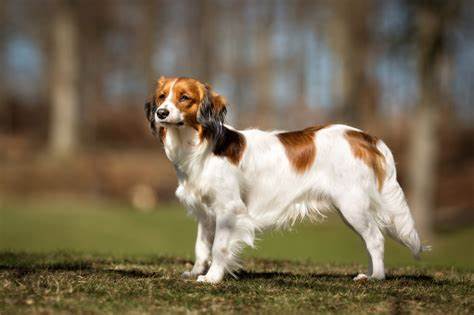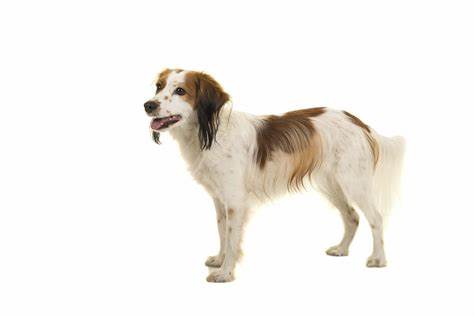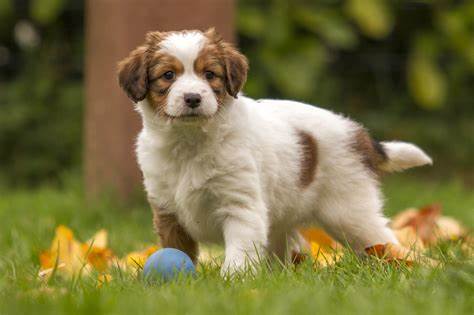
The Nederlandse Kooikerhondje (pronounced Koi-ker-hond-yuh) is a small sporting dog with a rich Dutch heritage. The breed originated in the Netherlands during the 16th century and was primarily used to lure ducks into traps or decoys, a hunting method known as “kooien.” The term “Kooiker” refers to the decoy hunter, and “hondje” means “little dog,” hence the name “little decoy dog.”
Kooikerhondjes appear in Dutch art from the 17th century, including paintings by Rembrandt and Jan Steen. The breed nearly went extinct during World War II, but through the efforts of Baroness van Hardenbroek van Ammerstol, it was revived and restored. The Kooikerhondje was officially recognized by the Dutch Kennel Club in 1971 and by the American Kennel Club in 2018 as part of the Sporting Group.
While still relatively rare outside the Netherlands, the Kooikerhondje is gaining traction among enthusiasts of intelligent, active breeds. It has a loyal following in Europe and is slowly becoming known in North America. Its appealing blend of charm, agility, and friendliness makes it an ideal companion for active families or sport dog competitors.
The Kooikerhondje is a small to medium-sized spaniel-type dog with elegant proportions and a bright, expressive face.
Coat:
Medium-length, slightly wavy or straight, with a soft, water-resistant undercoat. Feathering on the legs and tail.
Color:
Always orange-red patches on a white base. Black-tipped ears, known as “earrings,” are a breed hallmark.
Size:
• Height: 14–16 inches (36–41 cm)
• Weight: 20–30 lbs (9–14 kg)
Head & Expression:
A moderately rounded skull with a well-defined stop and a black nose. Eyes are almond-shaped and dark brown, giving a gentle, alert expression.
Body:
Slightly longer than tall, with a level topline, strong neck, and moderate bone.
Tail:
Long and well-feathered, carried level with the back or slightly upward when in motion.
The Kooikerhondje is known for its cheerful disposition, keen intelligence, and eagerness to work.
Energetic and Athletic:
Bred to be agile and alert, this breed thrives on activity and mental stimulation.
Sensitive and Friendly:
They are gentle and affectionate with family members but can be reserved around strangers.
Trainable and Smart:
Quick learners who enjoy positive reinforcement training. Ideal candidates for agility, obedience, and other dog sports.
Alert and Watchful:
Not aggressive, but they make excellent watchdogs and will alert their owners to unusual sounds or activity.
Playful and Lively:
Good with children and other pets when properly socialized. They love games and being part of family activities.

Versatile and Adaptable:
Equally suited to country or suburban living, provided they get enough exercise.
Great for Dog Sports:
Agility, flyball, and obedience are right up their alley.
Low Odor, Minimal Shedding:
Their coat is relatively easy to manage, and they don't typically have a "doggy" smell.
Good Size for Families:
Compact without being too fragile, they make great house dogs.
Unique Heritage:
For those who love rare breeds with rich stories, the Kooikerhondje is a true gem.
Training:
Start early with positive reinforcement. They can be sensitive to harsh correction but excel with praise and treats.
Exercise:
Daily walks, playtime, and training sessions keep this breed mentally and physically fit.
Grooming:
Brush weekly to prevent matting. Pay attention to feathering and clean ears regularly.
Diet:
Feed a high-quality diet suitable for active medium-sized dogs. Watch their weight as they can become overweight if under-exercised.
Living Conditions:
They adapt well to various home environments but are best suited to homes with access to a yard or regular outdoor time.

The Nederlandse Kooikerhondje is generally a healthy breed, thanks in part to careful preservation of its bloodlines.
Lifespan: 12–15 years
Potential Health Issues:
• Patellar luxation
• Epilepsy
• Hereditary necrotizing myelopathy (ENM)
• Von Willebrand’s disease
Responsible breeders test for these conditions, so always choose a reputable source.
Compared to the Cavalier King Charles Spaniel, the Kooikerhondje is more energetic and sportier, with stronger working instincts. The Cavalier tends to be more of a lap dog, while the Kooiker needs regular physical and mental activity.
When compared to the Papillon, both breeds are small, intelligent, and agile, but the Kooikerhondje is sturdier and more reserved. Papillons are often more outgoing and more suited to apartment life.
Choose this breed if you:
• Want an active companion for sports or hiking
• Are interested in a rare breed with a unique job history
• Enjoy training and mentally engaging your dog
• Prefer a smaller dog with working instincts
Not Ideal For:
• People looking for a low-energy lap dog
• Households that can’t provide consistent training or exercise
• Homes where dogs are left alone for long periods
United Pet Club can guide you to responsible breeders, provide pet care tools, and connect you with trainers and veterinarians to ensure your Kooikerhondje thrives from the moment they come home.